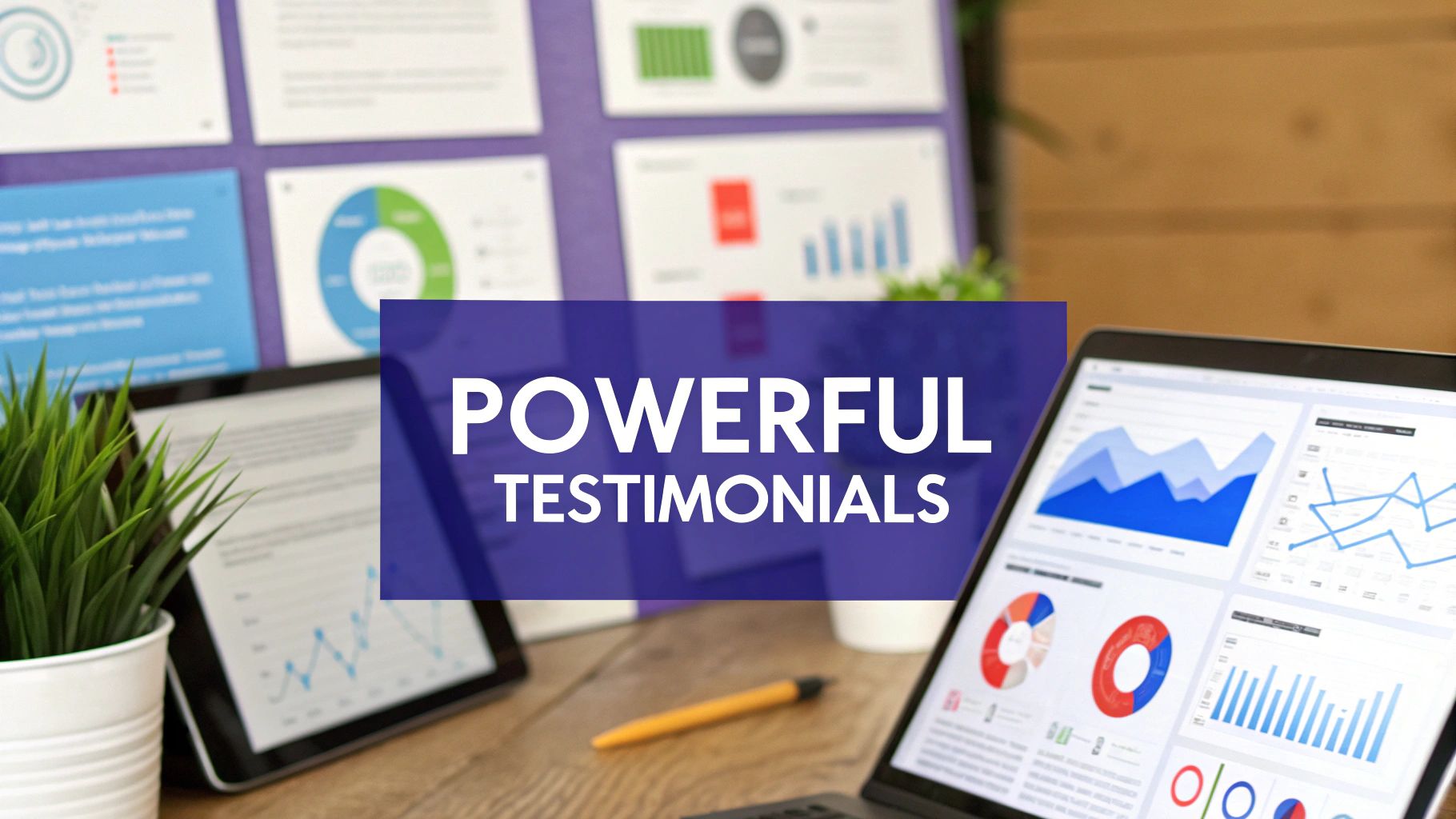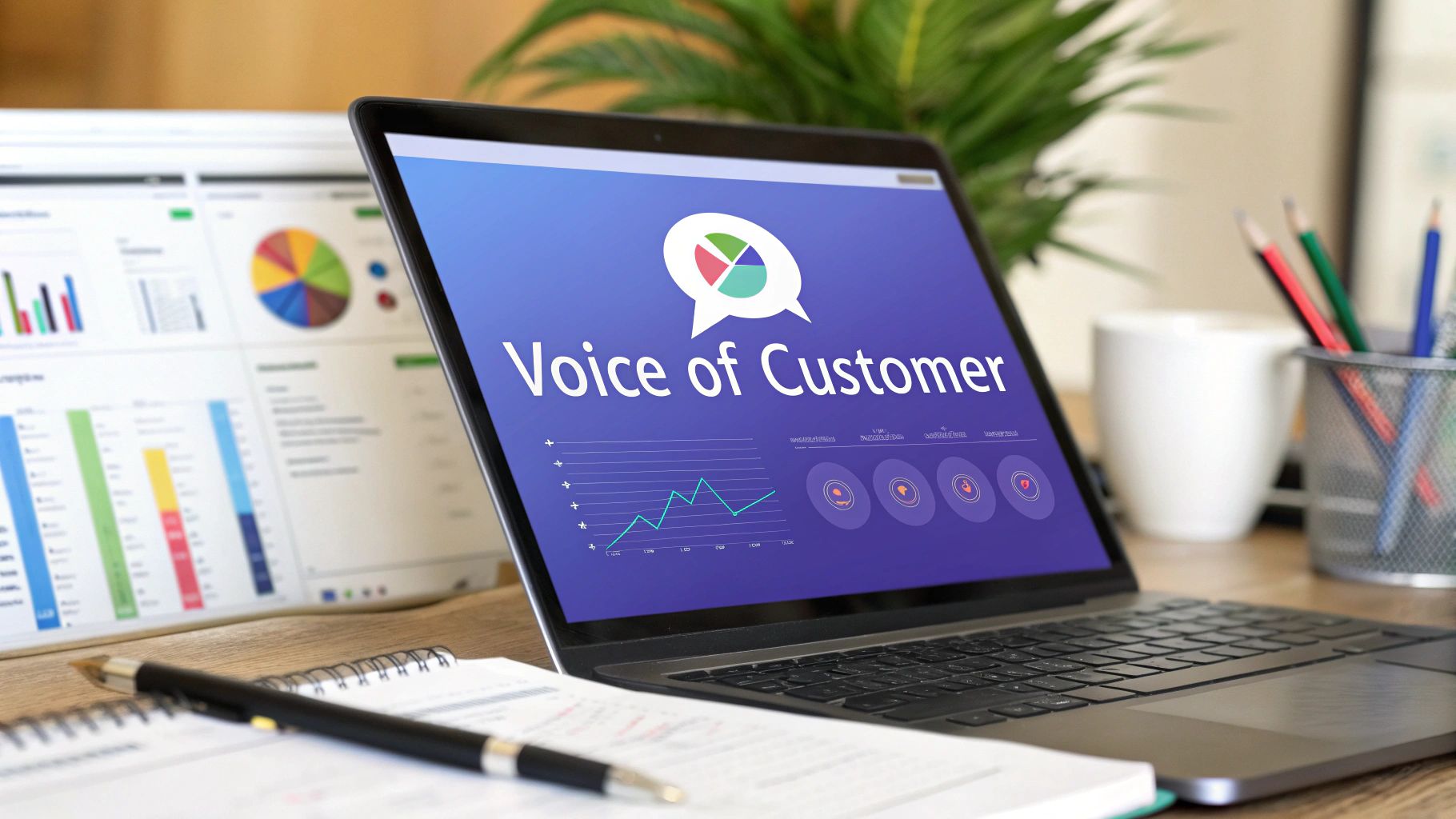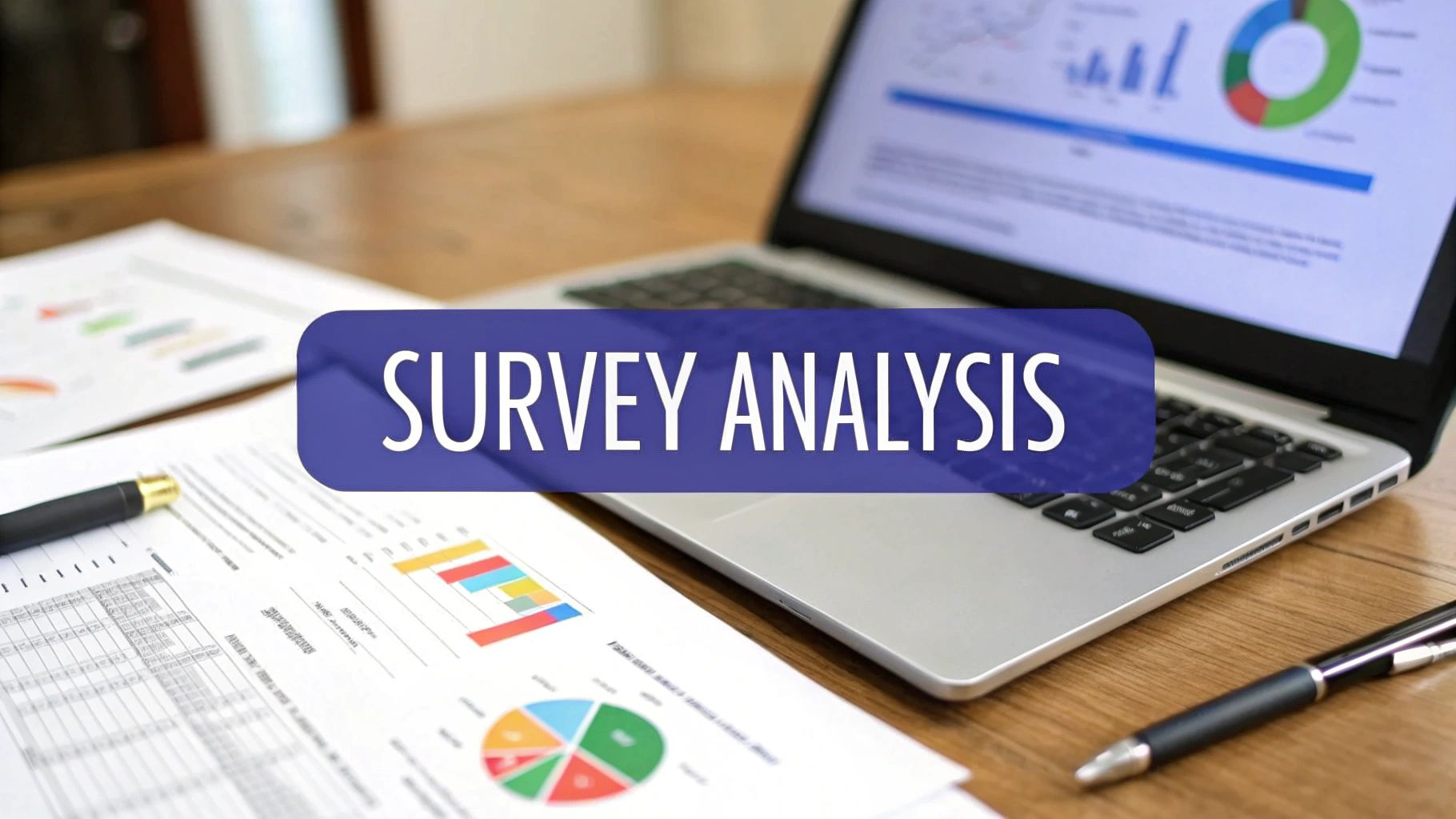6 Example of Open Ended Question Types for SaaS in 2025
Unlock deep user insights with our guide. Discover every example of open ended question you need for SaaS feedback, churn prevention, and growth.

In the competitive SaaS landscape, understanding the 'why' behind user behavior is no longer a luxury-it's the core of sustainable growth. While simple yes/no or multiple-choice questions provide clean data, they often miss the rich, nuanced feedback that sparks innovation and builds genuine customer loyalty. This is where the power of open-ended questions comes into play. They invite your users to tell their stories, share their frustrations, and articulate their needs in their own words.
For any SaaS business aiming to reduce churn, refine product features, and deeply understand its customer journey, mastering this skill is critical. This guide moves beyond a simple list; we will dissect six powerful types of questions, providing a strategic example of open ended question for various scenarios. You will learn not just what to ask, but how to analyze the responses to drive meaningful action, turning qualitative feedback into your most valuable asset.
This process of inquiry is crucial for both customer and internal systems. Just as understanding your customers requires asking the right open-ended questions, getting valuable output from AI tools hinges on your ability to frame effective prompts. You can discover more about strategies for writing effective AI prompts to improve your internal workflows. By mastering both external and internal communication, you can transform complex conversations into actionable data that fuels your entire growth strategy.
1. The Empathetic Perspective Question: Seeing Through Your Customer's Eyes
To truly innovate, you must understand your user's world. The Empathetic Perspective question is a powerful tool designed to move beyond feature requests and into the emotional context of your customer's experience. It asks your team and your users to step into someone else's shoes, fostering a deeper understanding of nuanced challenges and unspoken needs. This is a prime example of open ended question that uncovers the why behind user behavior.

For a SaaS platform, this isn't just about feeling good; it's about identifying usability hurdles for diverse user segments, from a brand-new employee navigating your onboarding to a power-user with unique accessibility needs. By prompting this shift in perspective, you uncover insights that standard feedback forms would never capture, leading to a more inclusive and intuitive product.
Strategic Analysis & Application
This question type is most effective during the discovery phase of product development or when analyzing customer support interactions. It helps product managers and UX designers build more accurate user personas and journey maps. For example, asking your support team, "How might a non-technical founder feel when setting up our API integration for the first time?" can reveal critical gaps in your documentation or UI that were previously invisible. The goal is to collect qualitative stories that highlight emotional friction points.
Key Takeaway: Use Empathetic Perspective questions in internal brainstorming sessions and targeted user interviews to build a product that solves not just a functional problem, but an emotional one too. This builds a stickier, more human-centric platform.
Examples in Action
- For Onboarding: "Putting yourself in the shoes of a new user, what's one thing that might feel confusing or overwhelming during the first 30 minutes of using our platform?"
- For Feature Development: "Imagine you are a freelance designer using our tool to manage five different clients. What's the biggest daily frustration you would likely face?"
- For Accessibility: "How might a user with a visual impairment experience our new dashboard, and what barriers might they encounter?"
How to Implement This Strategy
To get the most value from this approach, you need to create the right environment and ask with precision.
- Use Specific Scenarios: Instead of abstract concepts, frame the question around a concrete task or user role.
- Foster Psychological Safety: Ensure respondents, whether internal team members or customers, feel safe to share honest, potentially critical feedback without judgment.
- Dig Deeper with Follow-ups: Use responses as a starting point. Ask "Can you tell me more about that?" or "What part of that process feels frustrating?" to get to the core issue.
This method helps you move beyond surface-level data to gather rich, actionable narratives. If you're looking for more ways to structure your outreach, you can learn more about how to get customer feedback to complement this technique.
2. The Hypothetical Scenario Question: Unlocking Creative Solutions
To break free from incremental improvements, you need to explore what's possible beyond current constraints. The Hypothetical Scenario question removes real-world limitations like budget, time, or technical debt, inviting respondents to imagine an ideal future state. This approach is excellent for uncovering ambitious ideas and understanding core user desires. It is a fantastic example of open ended question because it prompts visionary thinking rather than just practical feedback.
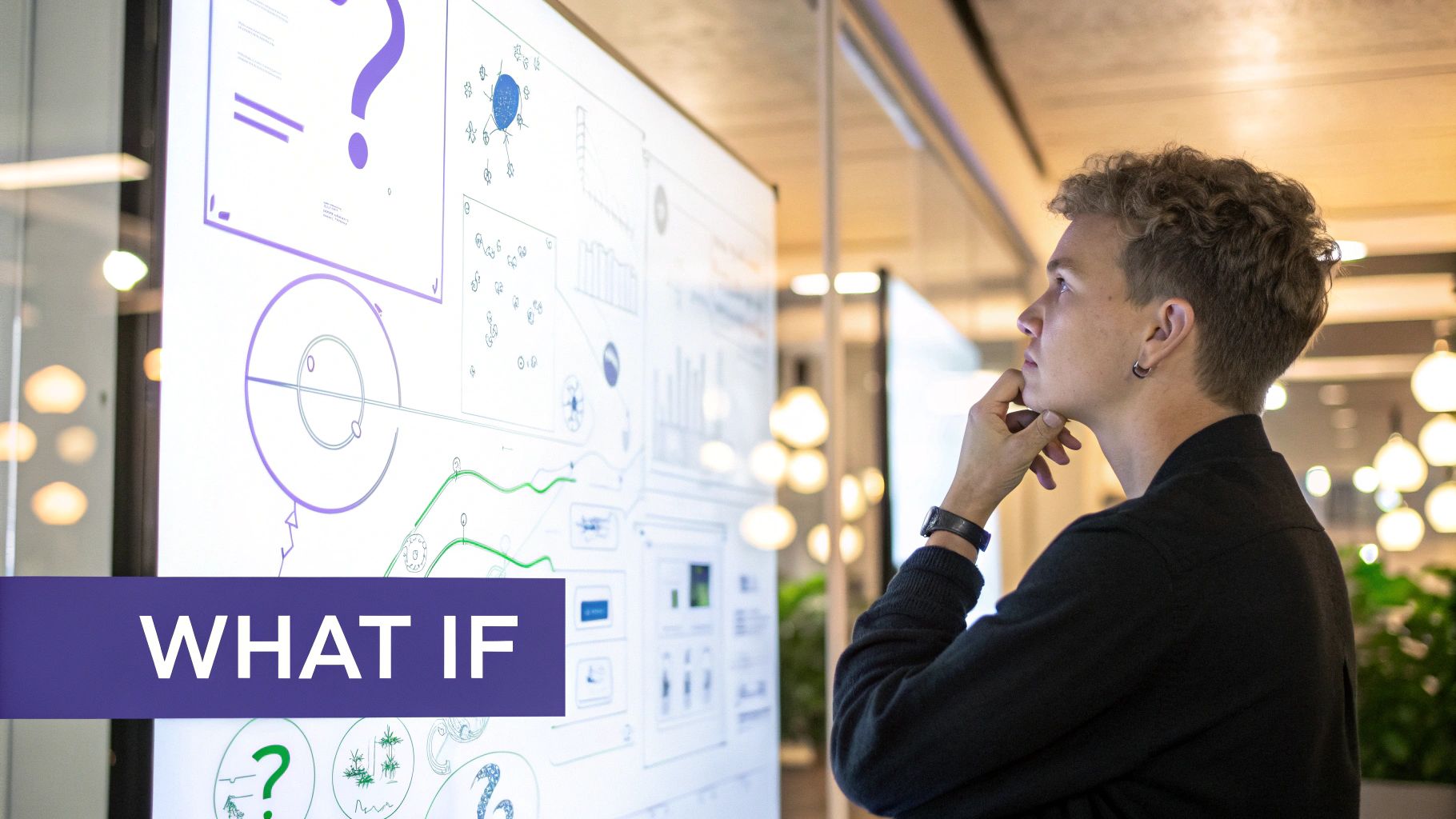
For a SaaS business, this technique can reveal the ultimate job-to-be-done your customers are hiring your product for. By asking users to envision a perfect solution, you gain access to their deepest strategic goals and frustrations. This method, popularized by strategic planning and the Harvard Business School case study method, helps you innovate on a whole new level, moving beyond simple feature adds to true product transformation.
Strategic Analysis & Application
This question type is most potent during strategic planning, product roadmap sessions, or when trying to solve a complex, long-standing user problem. It empowers product managers and growth leaders to think big and identify breakthrough opportunities. For example, asking a key customer, "If you had a magic wand and could instantly change one thing about how you manage client projects with our tool, what would it be and why?" can surface profound insights about their desired workflow that you would never get by asking "What feature should we build next?".
Key Takeaway: Deploy Hypothetical Scenario questions in strategy workshops and high-value customer interviews to escape the gravity of existing limitations. The goal isn't to build every "magic" feature, but to understand the fundamental problems behind the wishes.
Examples in Action
- For Product Vision: "Imagine you are the CEO of your company for a day, with a mandate to improve operational efficiency. What changes would you make to our platform to help you achieve that goal?"
- For Process Improvement: "If you could redesign our entire billing and invoicing process from scratch, what would your ideal system look like?"
- For Churn Analysis: "Let's say a perfect alternative to our product appeared tomorrow. What specific capabilities would it need to have to convince you to switch?"
How to Implement This Strategy
To generate valuable, creative responses, the scenario must be framed correctly.
- Make Scenarios Relatable: While hypothetical, the situation should connect to the respondent's actual role and challenges.
- Provide Clear Context: Briefly set the scene. Remove specific constraints like "with our current technology" to encourage blue-sky thinking.
- Explore the 'Why': The initial answer is just the beginning. Follow up with questions like, "What would that allow you to do that you can't do now?" or "Why is that particular change so important to you?".
This strategy pushes stakeholders and customers past conventional thinking, providing a treasure trove of innovative ideas that can define your product's future direction.
3. The Reflective Experience Question: Uncovering Past Behavior to Predict Future Needs
To understand how a user truly values your product, you need to look at their past behavior. The Reflective Experience question prompts customers to recall and analyze specific moments in their journey. This powerful technique, rooted in experiential learning theories, encourages users to move beyond hypothetical scenarios and share concrete stories about their successes and failures with your tool. This is a classic example of open ended question that reveals the real-world context and impact of your platform.
For a SaaS business, these reflections are gold. They provide a narrative account of how your product performs under pressure, how users overcome challenges, or why a specific feature became indispensable. This method uncovers the "aha!" moments and critical friction points that define the customer lifecycle, offering insights that are far more valuable than simple satisfaction ratings.
Strategic Analysis & Application
This question type is invaluable for churn analysis, case study development, and identifying power-user behaviors. It allows customer success and product teams to understand the sequences of events that lead to both loyalty and cancellation. For instance, asking a long-time customer, "Tell me about a time our platform helped you overcome a significant project challenge," provides a story you can use in marketing materials and a blueprint for replicating that success with other users. The goal is to collect detailed anecdotes that illustrate your product's tangible value.
Key Takeaway: Deploy Reflective Experience questions in exit surveys and in-depth user interviews to understand the triggers behind key customer behaviors. These stories provide powerful, qualitative data to explain your quantitative metrics, helping you reduce churn and enhance user activation.
Examples in Action
- For Churn Analysis: "Can you describe a project that didn't go as planned while using our tool? What would you do differently if you faced that situation again?"
- For Customer Success: "Tell me about a time you felt you got the most value from our product. What were you trying to achieve, and how did our platform help?"
- For Product Development: "Reflecting on your first month with us, what was one feature or workflow that surprisingly became essential to your daily routine?"
How to Implement This Strategy
To elicit meaningful stories, you must frame your questions carefully and create a space for honest reflection.
- Allow Processing Time: These questions require recall and thought. Don't rush the user for an immediate answer, especially in an interview setting.
- Use Specific Prompts: Instead of asking "How's it going?", ask "Tell me about a time..." to guide the user toward a specific memory.
- Focus on Learning and Growth: Frame the conversation around insights, not judgment. This encourages users to be open about what went wrong, which is often where the most valuable lessons are found.
- Ask Follow-up Questions: Once you have the story, dig deeper. Ask "How did that make you feel?" or "What was the key insight you took from that experience?" to understand the emotional and practical impact.
4. The Exploratory Discovery Question: Uncovering Unknown Opportunities
Before you can solve a problem, you must first understand the landscape. The Exploratory Discovery question is your team's compass for navigating unknown territories, designed to uncover new information, reveal unexpected insights, and generate novel ideas. Unlike questions that validate existing hypotheses, these broad prompts are used in research, innovation, and strategic planning to map out entirely new perspectives. This type of query is a fundamental example of open ended question for when you don't yet know what you don't know.
For a SaaS company, this is the starting point for true market disruption. It’s about asking questions that don't have a known answer, pushing your team beyond incremental improvements and towards breakthrough innovations. Whether exploring new markets or reimagining core features, these questions initiate the conversations that lead to your next big thing.
Strategic Analysis & Application
Exploratory questions are most potent at the very beginning of a project lifecycle, such as during initial market research, blue-sky brainstorming sessions, or when trying to understand a complex, undefined user problem. They are the backbone of ethnographic research and design thinking, helping teams gather a wide-ranging set of qualitative data before narrowing their focus. For instance, a product team might ask, "Tell us about your entire process for managing team projects from start to finish." This uncovers workflows, tool-stacking habits, and pain points that exist outside the confines of your current product, revealing opportunities for new features or integrations.
Key Takeaway: Use Exploratory Discovery questions to build a foundational understanding of a domain or user group. The goal is not to find immediate answers but to collect a rich tapestry of stories, behaviors, and ideas that will inform future, more targeted research.
Examples in Action
- For Market Research: "What are the biggest shifts you've seen in your industry over the past two years, and how have they impacted your daily work?"
- For Product Innovation: "If you could wave a magic wand and change anything about how you collaborate with your team, what would you change and why?"
- For Understanding User Behavior: "Walk me through a typical 'day in the life' of your role, focusing on the tools and information you rely on most."
How to Implement This Strategy
To effectively leverage exploratory questions, the process is just as important as the prompt itself.
- Start Broad, Then Go Deep: Begin with a wide-angle question and use follow-ups to probe interesting threads. If a user mentions a "frustrating report," ask "Can you tell me more about what makes that report frustrating?"
- Embrace Silence: After asking, give the respondent ample time to think and formulate their thoughts. Rushing to fill the silence can cut off valuable, deeper insights.
- Look for Patterns: The value comes from synthesizing responses. Analyze transcripts from multiple interviews to identify recurring themes, pain points, and surprising behaviors that point to an unmet need.
This method is essential for any team looking to innovate rather than just iterate. For more ways to frame your initial discovery conversations, you can explore additional open questions examples that fuel creative problem-solving.
5. The Future-Oriented Visioning Question: Co-Creating Your Product's Future
To build a product that stays relevant, you need to understand not just where your customers are today, but where they want to go tomorrow. The Future-Oriented Visioning question invites customers into the strategic planning process, transforming them from users into co-creators. It shifts the conversation from immediate bug fixes to long-term aspirations, helping you align your roadmap with their goals. This is an excellent example of open ended question that uncovers the strategic direction your users value most.

For a SaaS company, asking about the future is not just a thought exercise; it's a powerful source of competitive advantage. Understanding a user's vision for their own business growth reveals the features and capabilities they will need from your platform to succeed. These insights are invaluable for building a product that evolves with its customers, increasing loyalty and long-term value.
Strategic Analysis & Application
This question type is most potent during roadmap planning sessions, high-value customer check-ins, or when exploring potential market expansion. It helps product managers and growth leaders identify trends and prioritize features that will enable future success for their user base. For instance, asking a power-user, "If our tool could do anything to help you double your business in the next two years, what would that look like?" can generate groundbreaking ideas that go far beyond incremental improvements. The objective is to gather visionary insights that inform your long-term product strategy.
Key Takeaway: Use Future-Oriented Visioning questions with your most engaged customers to build a forward-looking product strategy. This ensures your development efforts are aligned with the future needs of your target market, preventing churn and fostering innovation.
Examples in Action
- For Roadmap Planning: "Looking ahead 12 months, what is the single biggest business goal you hope to achieve, and how could our platform help you get there?"
- For Customer Success: "Imagine your team is operating at peak efficiency in five years. What role does our software play in that ideal future?"
- For Enterprise Clients: "How do you envision this product evolving to support your company's long-term strategic initiatives?"
How to Implement This Strategy
To get actionable visions instead of vague wishes, you must guide the conversation effectively.
- Balance Aspiration with Realism: Encourage big-picture thinking but follow up by gently grounding the conversation. Ask what a first step towards that vision might be.
- Encourage Vivid Descriptions: Prompt users for specifics. Ask "What does that feature actually do?" or "How would that change your daily workflow?" to get tangible details.
- Connect Vision to Current Actions: Use the insights to inform your strategy. The answers to these questions are the building blocks of a powerful product vision. If you need help structuring these insights, you can learn more about how to create a product roadmap that truly reflects customer aspirations.
This approach transforms customer feedback from a reactive measure into a proactive strategic asset, ensuring your SaaS platform is not just useful today, but indispensable tomorrow.
6. The Problem-Solving Process Question: Unlocking Collaborative Solutions
When you're facing a complex customer issue or an internal roadblock, the right questions can transform a complaint into a blueprint for improvement. The Problem-Solving Process question is a methodical approach that guides respondents through identifying root causes, brainstorming solutions, and planning implementation. This structured inquiry is a powerful example of open ended question because it deconstructs a challenge into manageable, actionable parts.
These questions, popularized by frameworks like Design Thinking and the McKinsey problem-solving methodology, move beyond simple feedback to co-create solutions. Instead of just asking what is wrong, you guide the user or team member to explore why it's happening, how it could be fixed, and what is needed to make that fix a reality. This collaborative approach empowers users and uncovers practical, well-vetted ideas.
Strategic Analysis & Application
This question type is invaluable for SaaS companies during critical feedback loops, such as post-churn surveys, user acceptance testing (UAT), or internal retrospectives. It shifts the dynamic from a one-sided complaint session to a collaborative workshop. For instance, asking a recently churned customer, "What steps do you think we could have taken to prevent the core issue you faced?" provides far more strategic value than a simple "Why did you leave?" The goal is to collect a structured analysis of the problem and potential fixes directly from the source.
Key Takeaway: Use Problem-Solving Process questions to turn critical feedback points into constructive, solution-oriented conversations. This empowers users to become partners in your product's evolution and provides your team with a clear path forward.
Examples in Action
- For Product Development: "What do you believe is really at the root of the friction you're experiencing with our new reporting feature?"
- For Customer Churn: "If you had a magic wand and could change one thing about our process to better solve your primary challenge, what would that be and why?"
- For Internal Process Improvement: "What resources or support would our team need to fully implement your preferred solution to this workflow bottleneck?"
How to Implement This Strategy
To effectively guide someone through problem-solving, your questions must be sequenced logically. This structured flow helps organize thoughts and leads to more practical outcomes. The process generally follows three key stages.
This infographic illustrates the core flow of this questioning strategy.
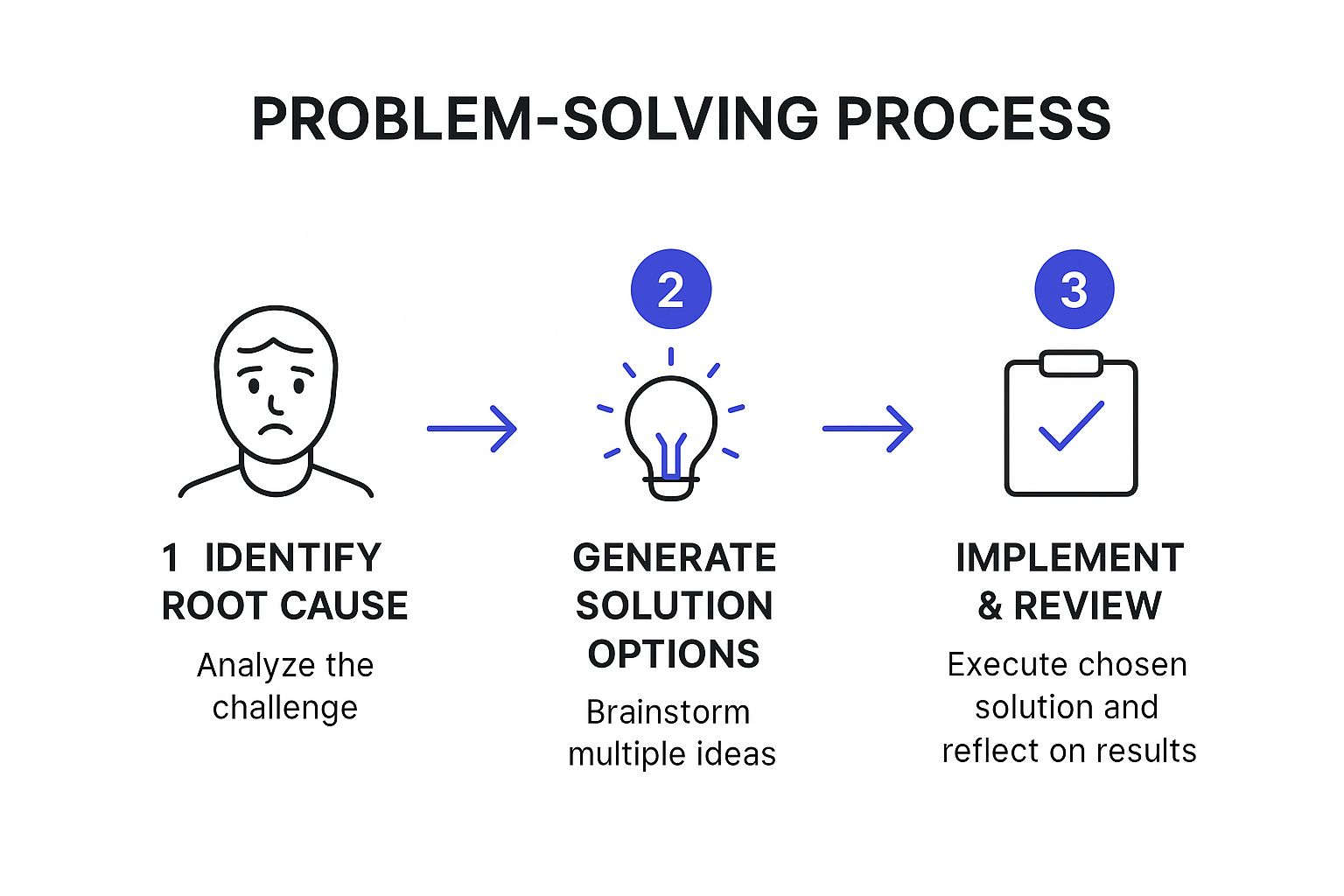
By moving sequentially from cause to solution to implementation, you ensure a thorough and practical analysis of any challenge.
- Break Down Complexity: Tackle one part of the problem at a time. Start with the root cause before jumping to solutions.
- Encourage Multiple Options: Ask "What are a few different ways we could approach this?" to avoid fixation on the first idea.
- Focus on Action: Frame the final questions around tangible next steps, resources, and support to ensure the ideas are realistic and implementable.
Open-Ended Question Types Comparison
From Questions to Growth: Turning Feedback into Action
Throughout this guide, we have moved beyond simply listing an example of open ended question. Instead, we've dissected the strategic architecture behind six powerful question archetypes, from the Empathetic Perspective Question that builds user-centric roadmaps to the Future-Oriented Visioning Question that aligns your product with long-term market needs. The common thread is clear: the right question, asked at the right time, is not just a data point; it's a catalyst for strategic action.
Mastering these questions is the first critical step. However, the true competitive advantage for any SaaS business lies in operationalizing the answers. The insights gathered from a Hypothetical Scenario Question can directly inform your pricing and packaging experiments, while feedback from a Problem-Solving Process Question can pinpoint friction points your analytics might miss, helping you reduce churn before it happens.
Bridging Insights and Execution
The journey from qualitative data to tangible growth requires a systematic approach. It’s about creating a direct, unbroken line from customer feedback to your product backlog, marketing campaigns, and customer success playbooks. The goal is to build a resilient feedback loop where user narratives actively shape your business strategy.
Here are the key takeaways to transform your approach:
- Systematize Collection: Don't treat feedback as a one-off campaign. Integrate these open-ended questions into key touchpoints across the customer lifecycle: onboarding, post-support interactions, and cancellation flows.
- Analyze for Themes, Not Just Words: The real value isn't in a single response but in the aggregate themes, sentiments, and recurring ideas. Look for patterns that signal widespread pain points or untapped opportunities. This is where AI-powered analysis becomes indispensable for handling volume and extracting signal from noise.
- Close the Loop: Always communicate back to your users. Acknowledge their feedback and, when possible, share how their insights led to specific changes or improvements. This builds immense customer loyalty and encourages future participation.
Making Feedback Your Growth Engine
To truly operationalize this process, teams often benefit from structured, collaborative sessions to digest qualitative data. When aiming to transform feedback into actionable growth, leveraging various interactive techniques can significantly enhance the quality of insights, as seen in effective interactive workshop activities that help teams brainstorm and prioritize based on user input.
Ultimately, the power of a well-crafted example of open ended question is its ability to give you a story, not just a statistic. These stories are your guide to building a product that customers don’t just use, but one they champion. By embedding this process into your company's DNA, you stop guessing what users want and start building what you know they need, turning customer feedback from a simple metric into your most potent and sustainable growth lever.
Ready to turn thousands of customer conversations into your next big breakthrough? Surva.ai uses AI to automatically analyze, tag, and surface critical insights from your open-ended survey responses, so you can stop digging through spreadsheets and start taking action. Discover how Surva.ai can build your feedback engine today.
